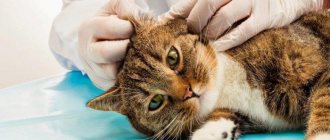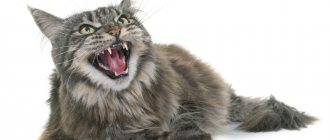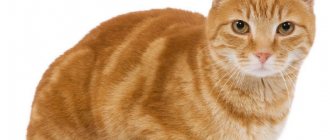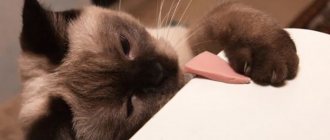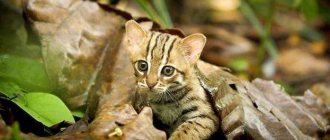Complications after sterilization in cats are truly rare. Most often they are associated with insufficient qualifications or negligence of the surgeon. Some problems, such as short-term constipation, are routine and doctors warn owners about them in advance.
I’ll tell you my point of view right away: all cats that do not participate in breeding must be sterilized. It's not just about unwanted kittens. This operation is necessary for the cat itself in order to live a long, quiet life.
Despite the low rate of complications, the sterilization procedure must be approached responsibly. In this article I will talk about what problems there are after castration of females, as well as how to avoid them!
—>
Constipation in a cat after sterilization: what to do, why it occurs
I always warn my patients: after sterilization, the cat should pee regularly, but at first there may be no stool. If after 3 days the pet does not go to the toilet in a big way, you need to take action.
There are several reasons for intestinal dysfunction. Firstly, this is a long-term starvation diet. Before anesthesia, you can feed the cat 10-12 hours. But if the operation is scheduled for the middle of the day, owners can increase this interval (do not feed the cat in the middle of the night!). Plus, the cat does not receive food for some time after the operation. As a result, she simply has nothing to poop with; it takes time for feces to form.
The second reason is the effect of drugs that are used for anesthesia in cats. Agents for intramuscular anesthesia (Domitor, Rometar, xylazine) not only significantly reduce body temperature in animals, but also affect the motility of the digestive tract. Because of this, intestinal peristalsis on the first day after surgery may be sluggish, and vomiting is possible.
The third reason for constipation after sterilization is simple stress associated with a trip to the clinic, surgery and wearing a blanket. Clothes can irritate your cat and make it difficult for you to get comfortable in the litter box.
If on the 3-4th day after the operation there is no long-awaited pile in the tray, you need to give the cat a mild laxative. It could be:
- A teaspoon of petroleum jelly (about 3 ml)
- A tablespoon of condensed milk half and half with water.
Vaseline oil is given twice a day until the cat has a bowel movement. This is liquid paraffin, the product has no taste or smell, and most importantly, it is not absorbed at all in the digestive tract. It is sold in human pharmacies, no other oil is suitable!
Pleurisy
Pleurisy
- inflammation of the pleura. There are primary and secondary; one-sided and two-sided; dry and wet (exudate); serous, serous-fibrinous, purulent and putrefactive pleurisy.
Etiology. Primary pleurisy occurs after hypothermia, especially in emaciated, old cats, and also as a complication of pneumothorax, pneumonia, and tuberculosis. The disease is characterized by a certain seasonality: in spring and autumn, in rainy weather pleurisy is more common. Pleurisy also occurs as a result of injury to the animal’s chest (for example, when a cat falls from a height).
With dry pleurisy, fibrin is layered on the pleura, sometimes the visceral and parietal layers of the pleura grow together (adhesive pleurisy). Exudative pleurisy occurs with the accumulation in the pleural cavity of first serous or serous-catarrhal exudate, which can later become purulent and putrefactive. Respiratory and cardiac functions become so difficult that they can cause the death of the cat.
Symptoms of the disease depend on the nature and extent of the lesions. The animal is lethargic, refuses food, the body temperature is elevated, an intermittent fever, shortness of breath, shallow, abdominal breathing are observed; with dry pleurisy - pain in the intercostal spaces; Friction sounds coincide with chest excursions. With effusion pleurisy - splashing noises on auscultation. The pulse is small wave, weak filling, the cardiac impulse is weakened, the sounds are muffled, tachysystole (signs of increasing heart failure).
The diagnosis is made on the basis of anamnesis, analysis of a set of symptoms, test puncture and X-ray data. The disease should be differentiated from hydrothorax and pneumonia. The course of the disease depends on the form and severity of the process. With proper treatment and care, pleurisy ends with recovery within 2-3 weeks. However, secondary pleurisy can last for months or even years (tuberculosis).
Purulent and putrefactive pleurisy often ends in death during the first decade of the disease with symptoms of hyperthermia and the depressed state of the animal.
Treatment must be comprehensive. They create a proper hygienic regime, ensure rest, and prescribe an easily digestible diet. For pleurisy, multivitamins, antibiotics, and sulfonamides are also indicated; UV irradiation, UHF therapy, Sollux. Diuretics, salicylates, and iodides are used. For purulent-putrefactive pleurisy, a puncture is made into the pleural cavity, the contents are sucked out and solutions of antiseptics (antibiotics, norsulfazole, ethacridine, etc.) are injected. Prevention of disease consists of preventing parasitic and infectious diseases, injuries, providing comfortable conditions for keeping the animal (excluding hypothermia, drafts, etc.).
Trichobezoars: ingesting their own hair
For 7-14 days, depending on the doctor’s recommendation, the cat walks in a blanket or collar after sterilization. This is necessary so that she does not lick the seam. But as a result, the cat is deprived of the opportunity to wash its entire body and tidy its fur.
After the blanket is removed, the cat begins to lick itself furiously. All this time the wool fell out, became tangled under the blanket, but was not renewed. As a result, the animal swallows a huge amount of its own fur. Of course, if you have a Sphynx or Cornish Rex, there is nothing to worry about. And if the cat is a long-haired breed (Maine Coon), it must be combed with a furminator after you take off its clothes.
Trichobezoars, hairballs, are manifested either by periodic regurgitation (vomiting) or by the same constipation (see point No. 1).
Pulmonary edema in a cat after sterilization
Long gone are the days when pets were anesthetized “by eye,” and the owners begged the doctor “not to overdo it.” Now veterinary clinics have modern and safe means of anesthesia. Large clinics use inhalation anesthesia and epidural anesthesia. Despite this, general anesthesia can cause dangerous complications in cats after sterilization.
If your cat has problems with the heart muscle (hypertrophic cardiomyopathy, congenital defects), pulmonary edema or thromboembolism may develop after surgery. Both complications can lead to the death of the animal, even if the owner notices something is wrong in a timely manner and consults a doctor.
As a doctor, I recommend doing a cardiac ECHO (ultrasound) before surgery. So we can be calm or, on the contrary, look for options for anesthesia and medicinal support. In practice, owners most often refuse the study to cut costs. With the words “Yes, this is a cat, what will happen to her.” To be fair, I note that most cats do tolerate anesthesia well. But there are breeds in which HCM (hypertrophic cardiomyopathy) occurs much more often than in outbred cats. Here are some popular cats that are at risk:
- Maine Coons;
- Sphinxes;
- British cats;
- Scottish cats.
Scottish Fold ECHO of the heart is a must
Owners should monitor their cat for at least two weeks after sterilization. The pet should eat, drink, and play as usual within 24 hours. If a cat refuses to eat, lies in one place, breathes with its mouth open like a dog, you should immediately contact a well-equipped clinic for diagnosis.
Saving money
Treatment of cardiogenic pulmonary edema in animals in the intensive care unit is very expensive. Monitoring your breathing rate while you sleep costs nothing.
But in order to make sense of assessing the breathing rate during sleep, three things are needed:
- You need to trust your doctor and learn to correctly count the animal’s breathing
- You need to count it and enter the graph
- You need to constantly contact your doctor and communicate during changes
In order to correctly learn how to count an animal’s breathing during sleep, send your doctor a one-minute video recording for control.
The cat's seam came apart after sterilization
A tiny cosmetic stitch after sterilization of a cat normally heals quickly without a trace. However, this is not always the case. Sometimes owners are forced to return to the clinic again because the cat’s stitch has come apart after sterilization.
The most common cause of this problem is neglect of the veterinarian's recommendations. If after surgery the cat does not wear a collar or blanket, it will tend to lick the stitches.
Together with saliva, an infection enters the wound, and severe inflammation (festering) of the suture occurs. In this case, no threads will hold the fabric together. In addition, with its rough tongue, a cat can get rid of stitches ahead of time.
If the suture discrepancy is minor, the doctor may prescribe “conservative” treatment. First of all, you need to stop the seam from licking. Then local blockades are made (Novocaine 0.5% with an antibiotic), the wound is washed 1-2 times a day. Sometimes healing ointments and preparations such as Vinilin are used. Treatments sometimes last a long time, 1-2 weeks, so I urge owners to take care of the suture immediately after surgery to avoid such problems.
Minor divergence of the cosmetic seam (the cat was not wearing a blanket)
If the suture is severely torn, the only treatment option is surgical revision of the suture under general anesthesia. The doctor will remove non-viable tissue and sew up the belly again. In this case, removable external sutures are usually placed and a systemic antibiotic is prescribed. Case from practice:
The cat was sterilized in a third-party clinic, the external and internal seams were made with silk, the cat did not wear a blanket
Severe seam divergence, 3 weeks have passed since sterilization
All non-viable tissue was removed and sutures were re-sutured.
The same cat after removal of stitches (12 days after wound revision)
Home care and prevention
Follow your veterinarian's directions. Keep your pet cool and away from stress and stress. Don't leave cats locked in your car.
The most important method of preventing complications for most pathologies that cause heavy breathing and shortness of breath is controlling your pet's weight. The cat must be in ideal condition; excess weight significantly aggravates any manifestations of respiratory failure, complicates diagnosis and treatment, and can cause the development of diabetes.
Rapid breathing in cats - video interview with a veterinary cardiologist:
Rejection of suture material
Sometimes a cat's stitch may come apart after sterilization, even if she did not lick the wound. If non-sterile suture material was used during the operation, and the rules of asepsis and antisepsis were not followed, the wound may become infected.
Most often, a negative reaction occurs to non-absorbable threads (silk), too thick, coarse threads. Sometimes it is enough to remove the nodule from the wound for the reaction to stop.
If there are problems with the seam, owners notice that the cat's blanket gets wet. Or some stains or smudges appear on it. After sterilization, the seam should be clean and dry, and the skin in the wound area should be tightly closed joint to joint. If you see swelling, redness or discharge (usually this is not pus, but something like ichor) in the suture area, immediately show your pet to the surgeon. Treatment of the problem is the same as if a cat licked a seam.
Rarely, cats have a true reaction to suture material (rejection). In this case, you need to use threads made of a different material or even a special metal wire, which is removed after the tissue has healed.
When should you worry?
If you notice that the cat is inhaling air suspiciously often, while he may open his mouth slightly and stick out his tongue, then measures should be taken and a qualified specialist will help in this situation. Most likely, the furry will be diagnosed with pathological processes in the respiratory organs. It is possible that the diagnosis will reveal a disease that is not directly related to the respiratory system.
Feline health problems that lead to rapid breathing:
- Diseases of the throat and trachea (edema, paralysis, collapse, oncology, etc.).
- Pathological processes in the bronchi (helminthic infestations, bronchitis, asthma). Then the pet will additionally have a dry cough and fever.
- Pathologies of the nose in cats (inflammatory processes, infections). When a purr, along with rapid breathing, wheezing and discharge from the nose are observed.
- Lung diseases (blockage due to a large number of worms, oncology, edema, inflammation).
- Abundance of air in the chest.
- Hernias in the diaphragm.
- Neoplasms in the breast with changes in the diameter of the lymph nodes.
- Heart problems (any heart failure, arrhythmias).
- Intoxication.
- Diseases of the endocrine system, hormonal imbalances.
- Anemia.
- State of shock.
- Fever.
- Dehydration or severe overheating.
If, in addition to rapid breathing, you find that your beloved cat has begun to behave suspiciously, his temperature has risen, shortness of breath has appeared and his heart rate has increased, you can hear wheezing in the chest and there is discharge from the mouth and nose, there is paleness or redness of the mucous membranes, then without hesitation, take the mustache to the veterinary clinic for diagnostics.
Hernia after sterilization of a cat
In my practice, I have never seen a hernia occur after sterilization of a cat. This is due to the short length of the incision required to remove the uterus and ovaries. However, such a complication does occur, so I will mention it. Sterilizing a cat is a abdominal operation. The doctor must carefully stitch up the abdominal incision. A hernia occurs when the sutures fail.
A hernia looks like a protrusion under the skin in the suture area and can be of different sizes. The omentum (internal fat on ligaments) or intestinal loops fall out through a hole in the abdominal wall. The hernia definitely requires repeated surgical intervention. The operation should not be delayed to avoid the formation of adhesions or strangulation of the hernia.
Young cats will have a very small incision before their first heat.
Causes
Diseases of the upper respiratory tract are most often associated with anomalies in the development of the oropharyngeal cavity, defects in the development of the skull in various breeds, trauma, neoplasms and infections.
The lower respiratory tract is characterized by viral or bacterial infection. Another cause of breathing disorders can be the entry of foreign bodies, cysts and tumors, as well as gas poisoning.
For chest diseases, they arise as complications of inflammatory lung diseases, traumatic injury and developmental abnormalities.
Internal bleeding in a cat after sterilization
The veterinarian places ligatures on the vessels supplying the ovaries and uterus before removing the reproductive organs. If such a ligature comes off, internal bleeding will occur. This probability is extremely low, and many clinics use vascular electrocoagulation technology instead of threads.
Life-threatening bleeding can occur if your cat has a blood clotting disorder. This is possible with rare congenital pathologies, or with a fatal coincidence of circumstances. On a free range, a pet can catch and eat a mouse that has been poisoned but is still alive. As a result, the cat is poisoned with an anticoagulant, which leads to spontaneous bleeding.
Signs of internal bleeding:
- The cat is lethargic, weak, inactive;
- The mucous membranes (gums) are white;
- Dyspnea.
In the clinic, the diagnosis can be confirmed using an ultrasound - fluid in the abdominal cavity after surgery indicates bleeding. If ultrasound diagnosis is not possible, a diagnostic puncture of the abdominal cavity is performed with a regular syringe.
Treatment consists of blood transfusions, plasma substitutes, and the administration of hemostatic drugs. If necessary, a repeat operation is performed to find and ligate the bleeding vessel.
The cat comes to life after sterilization
Viral infection
It is not entirely correct to call a viral infection a complication of sterilization. But I want to warn as many people as possible. Doctors try to maintain cleanliness and order in the clinic to the best of their ability. However, your cat may still encounter viruses brought in by other cats. It is better if she is vaccinated in advance. The ideal regimen is vaccination at 3 months and sterilization between 6-12 months. Then revaccination at 15 months, when the cat has fully recovered from the operation.
Alarming signs of various viral diseases (rinotracheitis, calicivirosis, panleukopenia):
- Excessive drooling;
- Ulcer on the nose, tongue;
- Nasal discharge, sneezing;
- lacrimation;
- Vomiting or diarrhea;
- Depression, refusal to eat.
If your animal feels unwell, it is better to call your doctor and discuss the course of action. Sterilization itself cannot cause poor appetite, loose stools or other symptoms.
Breathing assessment
This can be done by observation, counting the number of inhalations and exhalations in 30 seconds and multiplying this number by 2. Cats take between 20 and 40 breaths per minute. In this case, you should keep in mind the age and gender of the animal. Kittens breathe more often than adult animals, cats breathe more often than cats, pregnant, lactating and medium-sized cats also breathe more often.
In addition, a cat's breathing becomes more frequent in a state of excitement, increased activity, or in hot weather. If a cat's respiratory rate is above 40 per minute, observed for a long time and not caused by any of the factors listed above, this is a sign of ill health.
